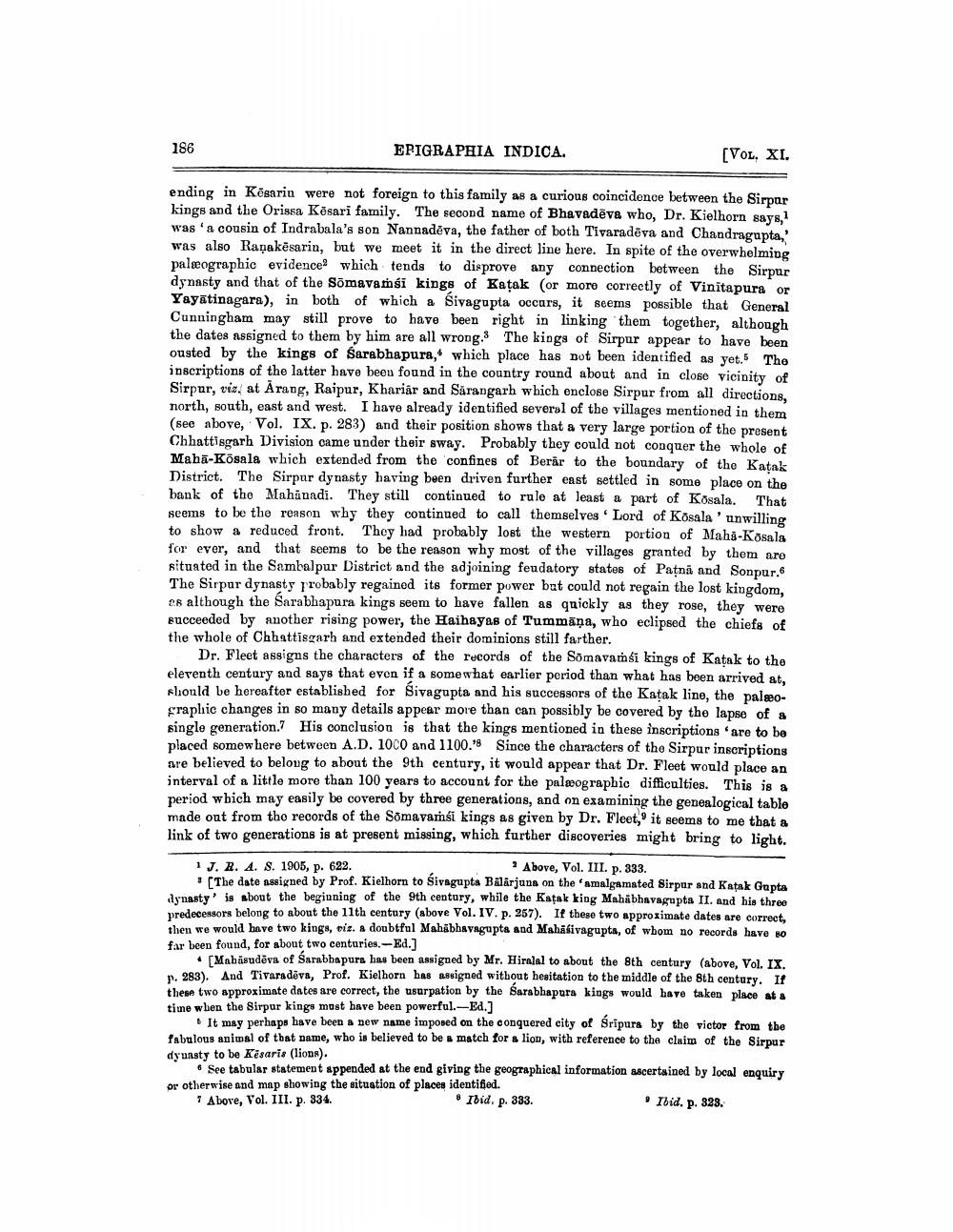________________
186
EPIGRAPHIA INDICA.
[VOL. XI.
ending in Kosarin were not foreign to this family as a curious coincidence between the Sirpar kings and the Orissa Kösari family. The second name of Bhavadēva who, Dr. Kielhorn says, was a cousin of Indrabala's son Nannadeva, the father of both Tivaradöva and Chandragupta, was also Rapakësarin, but we meet it in the direct line here. In spite of the overwhelming palæographic evidence which tends to disprove any connection between the Sirpur dynasty and that of the Somavamsi kings of Katak (or more correctly of Vinitapura or Yayātinagara), in both of which a Sivagupta occurs, it seems possible that General Cunningham may still prove to have been right in linking them together, although the dates assigned to them by him are all wrong. The kings of Sirpur appear to have been ousted by the kings of Sarabhapura, which place has not been identified as yet. The inscriptions of the latter have been found in the country round about and in close vicinity of Sirpar, vis, at Arang, Raipur, Khariar and Sarangarh which enclose Sirpur from all directions, north, south, east and west. I have already identified several of the villages mentioned in them (see above, Vol. IX. p. 283) and their position shows that a very large portion of the present Chhattisgarh Division came under their sway. Probably they could not conquer the whole of Maha-Kösala which extended from the confines of Berär to the boundary of the Katak District. The Sirpur dynasty having been driven further east settled in some place on the bank of the Mahinadi. They still continued to rule at least a part of Kosala. That seems to be the reason why they continued to call themselves. Lord of Kosala' unwilling to show a reduced front. They had probably lost the western portion of Mahs-Kosala for ever, and that seems to be the reason why most of the villages granted by them are situated in the Sambalpur District and the adjoining feudatory states of Patna and Sonpur.6 The Sirpur dynasty probably regained its former power but could not regain the lost kingdom, es although the Sarabhapura kings seem to have fallen as quickly as they rose, they were succeeded by another rising power, the Haihayas of Tummāņa, who eclipsed the chiefs of the whole of Chhattisgarh and extended their dominions still farther.
Dr. Fleet assigns the characters of the records of the Sõmavamsi kings of Katak to the eleventh century and says that even if a somewhat earlier period than what has been arrived at, shonld be hereafter established for Sivagupta and his successors of the Katak line, the palæographic changes in so many details appear more than can possibly be covered by the lapse of a single generation. His conclusion is that the kings mentioned in these inscriptions are to be placed somewhere between A.D. 1000 and 1100. Since the characters of the Sirpur inscriptions are believed to belong to about the 9th century, it would appear that Dr. Fleet would place an interval of a little more than 100 years to account for the palæographic difficulties. This is a period which may easily be covered by three generations, and on examining the genealogical table made out from the records of the Somavamsi kings as given by Dr. Fleet, it seems to me that a link of two generations is at present missing, which further discoveries might bring to light.
1 J. 2. 4. S. 1905, p. 622.
Above, Vol. III. p. 333 . The date assigned by Prof. Kielhorn to Sivagupta Balärjuns on the 'amalgamated Sirpur and Katak Gupta dynasty is about the beginning of the 9th century, while the Katak king Mahabhavagupta II. and his three predecessors belong to about the 11th century (above Vol. IV. p. 257). If these two approximate dates are correct, then we would have two kings, viz. a doubtful Mahabhavagupta and Mahāśivagupta, of whom no records have so far been found, for about two centuries.-Ed.]
Mahasudeva of Sarabbapura has been assigned by Mr. Hiralal to about the 8th century (above, Vol. IX. 283). And Tivaradova, Prof. Kielhorn has assigned without hesitation to the middle of the 8th century. If these two approximate dates are correct, the usurpation by the Sarabhapura kings would have taken place at a time when the Sirpur kings must have been powerful.-Ed.)
It may perhaps have been a new name imposed on the conquered city of Sripura by the victor from the fabulous animal of that name, who is believed to be a match for a lion, with reference to the claim of the Sirpur dyuasty to be Kesaris (lions).
See tabular statement appended at the end giving the geographical information ascertained by local enquiry or otherwise and map showing the situation of places identified. 1 Above, Vol. III. p. 334.
8 Ibid. p. 333.
. Ibid. p. 323.




